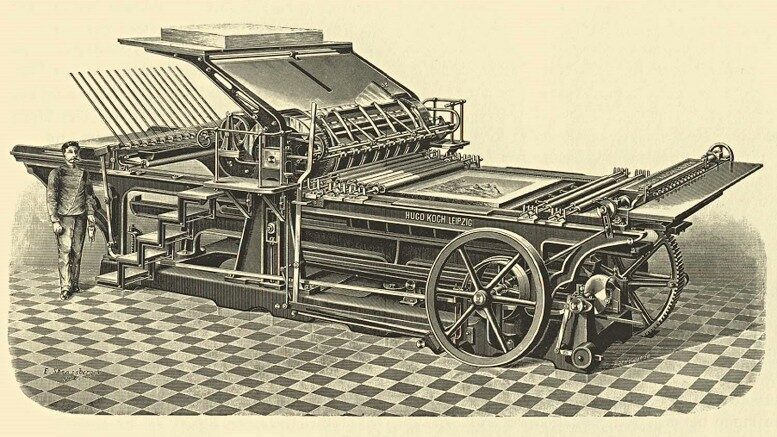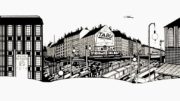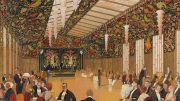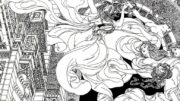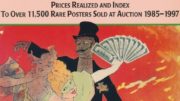“Innovative posters affixed to the façade of the horticultural society building have seized the attention of passers-by on the Ringstraße since they first appeared this morning”[1] – this is the opening of a newspaper article in the “Neue Freie Presse” describing a sensational Viennese exhibition in April 1888. Despite being on show for only twelve days, 14-25 April, the “Internationale Placat-Ausstellung” – or International Poster Exhibition – was of an impressive size. “Well over a thousand posters and advertisements from around the world”[2] attracted hosts of enthusiasts to the “flower rooms” of the horticultural building: on the first two days a total of 3,416 people came to see the exhibition[3], and the continued flow of visitors caused the exposition to remain open for two days longer than originally planned. Newspapers in Vienna published a number of reports on the exhibition, describing it – such as in “Die Presse” – as “one of the most original expositions” that “we have ever seen”[4].
Indeed, a poster display was an innovation in the exhibition world at the time. The Vienna poster exhibition was one of the first of its kind on an international level as well – and so it is all the more astounding that it apparently has yet to be recognised in specialist literature.[5] The exhibition in Vienna is even missing from the list of previous poster exhibitions included in the Catalogue de l’Exposition d’affiches artistiques that was published in 1896 for an exhibition in Reims.[6]
Newspapers reported[7] that the exposition was the brainchild of the economist and writer Alexander von Dorn (1838–1919). Dorn, who also collected publicity materials, held a talk entitled “Das Bild als Handelsagent” (The image as a sales agent) in the Imperial and Royal Austrian Trade Museum (k.k. Österreichisches Handelsmuseum) on 22 February 1888, where some of the exhibits shown at the International Poster Exhibition were already presented. During this talk (which he published afterwards in the “Volkswirtschaftliche Wochenschrift” economics weekly[8], of which he was editor), Dorn gave an overview of the history of visual merchandise promotion and discussed the significance of newly developed printing techniques for poster design as well as “the function of attracting consumers or buyers performed by illustrated affiches and advertisements. (…) The talk was illustrated with a tremendously rich and interesting exhibition. A vast amount of colourful English, American, French and Italian affiches, whose characteristic differences were identified by the lecturer, were hung on the walls of the room. An extensive collection of advertisements was also on show, which awakened great interest amongst the audience.”[9]
Members of the high-profile audience (the talk was attended by Archduke Karl Ludwig and several politicians[10]) included Wilhelm von Schwarz-Senborn (1816–1903), who subsequently became the principal organiser of the International Poster Exhibition. Dorn’s collection was also on show at the latter exhibition, augmented with numerous additional exhibits. The earnings – i.e. the entrance fees (20 kreutzer for adults, 10 for children) and the proceeds from an auction of exhibits after the display had closed – were to be donated to a good cause. Schwarz-Senborn, who had been posted as a diplomat to London, Paris and Washington and who had held the position of director general of the Vienna World Exposition in 1873, was also committed to educating the general public. One of his functions was as founder and chairman of a non-profit association that ran an “open reading hall” in Vienna’s 9th district (Nußdorferstraße 3) from 1880, with several thousands of books and numerous newspapers/magazines. All residents of this district were permitted to use the reading hall free of charge, and also take books out on loan.[11] The proceeds from the poster exhibition were intended to secure the future of this first public library in Vienna, which had registered an impressive number of 218,973 readers by 1888.
Wilhelm von Schwarz-Senborn used his “connections across the world”[12] to organise as many international posters as possible for the exhibition – and a considerable amount of money was paid in levies for them. For example, the “Wiener Allgemeine Zeitung” reported that on the day before the exhibition opened, “new shipments from abroad were still arriving, notwithstanding the payment of custom duties amounting to 150 guilders by the harried, self-sacrificing event organisers, who contributed to taking the pressure off the Austrian financial budget.”[13] Local printers also sent their products for display at the exhibition. The Austrian/Hungarian book printing newspaper titled “Österreichisch-ungarische Buchdrucker-Zeitung” called on its readership to participate, and commented: “Exhibitors will not be charged stand rental fees or other costs, but they will relinquish their wares without receiving any compensation.”[14]
The exhibition was designed by Viennese architect Rudolf Feldscharek (1845–1919), who needed to have “new fixtures” made in order to accommodate all the exhibits, “even though the halls of the horticultural society and their adjoining rooms offer expansive wall space”[15]. As even more posters were delivered during the exhibition, and there was no room left for them, on 21 April “in the early hours of the morning before the exhibition opened for the day, some of the previously exhibited posters were exchanged for new ones.”[16]
The “Internationale Placat-Ausstellung” was publicised with 40,000 colourful “advertising flyers”[17] that were handed out on the Ringstraße, as well as with a poster that was designed by the painter Ladislaus Eugen Petrovits (1839–1907) and “colour-printed to great effect”[18]. A newspaper article in the “Neue Freie Presse” commented that it was “a felicitous idea on the part of the artist to frame the text on this poster with miniature reproductions of French, English, American and other posters to be shown in the exhibition.”
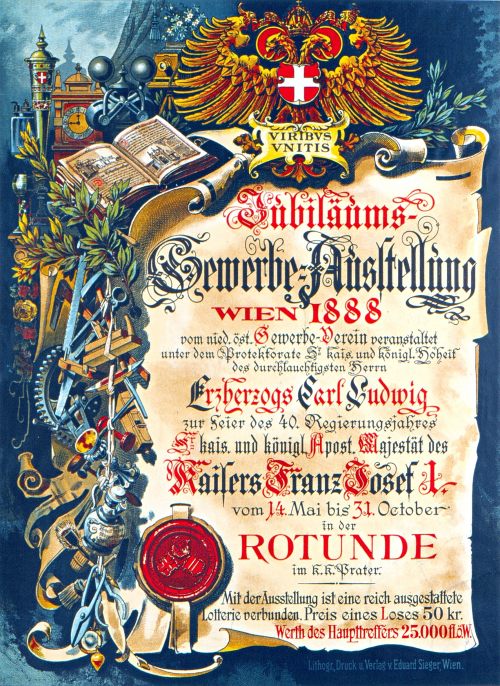
Ladislaus Eugen Petrovits, poster for the “Jubiläums-Gewerbe-Ausstellung” industrial exhibition in Vienna, 1888. Printed by “Eduard Sieger”, a company that played a prominent role in the 1888 poster exhibition
Much attention was paid to the posters from England and the USA at the exhibition, which “astonished the visitors with their truly enormous dimensions; many of them cover an area of 12 to 20 square metres”[19]. The series of US-American posters publicising P.T. Barnum’s circus left an especially remarkable impression. According to newspaper reports, posters from the following countries were also displayed: Australia, Belgium, Canada, France, Germany, Italy, the Netherlands, Spain and Switzerland. A total of 54 posters from Russia were on show and although – as established by a reporter from the “Teplitz-Schönauer Anzeiger” who was highly impressed by the exhibition – they were limited to “modest formats”[20], they left “nothing to be desired with regard to their artistic design”.
The area of the exhibition reserved for Austria presented “all the familiar posters on view in the streets and on advertising pillars.” The article continued: “An advertising pillar is also on show. Current theatre posters are exhibited as well. Danzer’s Orpheum and the Drittes Kaffeehaus im Prater have their own section in which all the posters from these establishments are exhibited in a harmonious arrangement.”[21] The presentation also included “an exceedingly interesting historical poster (…) for Franz Liszt’s first appearance in Budapest as an eleven-year-old boy”[22]. And the exhibition visitor from Teplitz-Schönau “could scarcely believe his eyes”: “Yes, it was true. In a golden frame, printed on red silk, was hanging a – playbill from Teplitz.”[23] One exhibit judged as particularly accomplished by “Die Presse” newspaper was the poster for the Lower Austrian spa town of Salzerbad-Kleinzell, which advertised the location “on a nine-foot board with words alongside a vivid, lifelike picture that seemed to emerge from the poster”[24]. The article commented: “Despite America and France being the greats in the world of advertising, in this case Austria has shown an original approach.”[25] The Schlöglmühl paper factory from Lower Austria was also represented at the exhibition, showing “an entire collection of their attractive affiche paper in rolls”[26].
Not one of the numerous reports on the International Poster Exhibition mentions the names of the designers who created the posters on show, although the printers were acknowledged in a number of cases. One of these was “A.S. Seer’s Printing Establishment” in New York, which produced the posters for Barnum’s circus. A whole wall was covered by posters printed in Budapest by “Czettel & Deutsch” (“to some extent quite cleanly made, but usually in smaller formats”[27]). The established Viennese printers that displayed their products included the company “Conrad Grefe” with “the beautiful poster for the International Art Exhibition“[28] (this is the poster designed by Julius Schmidt and Leopold Theyer for the 2nd International Art Exhibition in Vienna, 1888). Other exhibiting printers were “Haufler”, “Schmutterer & Co.”, “Eduard Hölzel”, “Schipek & Co.”, “Johann Vernay”, “J. Weiner” and the company “Eduard Sieger” which – according to the “Österreichisch-ungarische Buchdrucker-Zeitung” – was first in Vienna to use larger formats “and lent the poster a certain artistic chic. The company introduced the use of zinc for larger posters and is outstandingly represented at this exhibition as well.”[29]. The Viennese exhibitors also included Hartleben publishing company and Sinsler poster affixing institute.
The International Poster Exhibition triggered a series of theoretical deliberations on the poster as a medium. For instance, the “Wiener Allgemeine Zeitung” dedicated a large article in its feuilleton to the topic. Its author B.B. characterised the poster as follows:
“It obstructs us, it jumps to and fro, it dazzles us with its colours and figures, it makes us laugh and shudder, it is garrulous and emotive, you can get annoyed by it, but you can’t avoid it.” The article continues that the “right poster” is a “sight worth seeing”: “It must attract interest, outright and without any regard for what it has to say. The responsibility of the illustrator and colourist is to design a poster that is as sensational as possible. ‘Sensational’ in an artistic, moderate sense of the word because brutal cries reminiscent of street markets would arouse resistance in any educated person and thus spoil the intention behind the advertisement. A relationship between the pictorial and written content of the poster, even of a casual nature, will have to be present at all times. The more ingenious, striking, the better. The ideal of a poster is that which presents an immediate view – in a peculiar, elaborate, attention-seizing manner – of its purpose, whether this is a well-fitting ladies’ garter or a round-the-world trip. An explanatory headline, such as the title beneath a painting, must suffice as clarification. Passers-by on the street do not want to read – and they should not be forced to. They want to have as much as possible to look at.”[30]
The right design of the poster text was the central topic of many articles on the exhibition. “In particular, you should not deceive yourself that the text in such printed material is not a literary work, but without doubt it requires a good idea, a witty notion, to force observers hurrying past to pay it some attention,”[31] wrote the “Wiener Sonn- und Montagszeitung”. An example given in “Die Presse” (which also dedicated an extensive feuilleton to the poster exhibition signed by z.k.l.[32]) were the posters by the English soap manufacturer “Pears”, of which “around two dozen” were on show at the exhibition, such as “an old woman washing a grubby boy. Other posters showed pictures of famous artists, such as the opera singer Adelina Patti, full-sized, in an attractive photographic print, advertising Pears’ soap. (…) The text in these pictures is always brief, laconic, usually only with the two words ‘Pears’ Soap’ written in large, very clear, Uncial letters.”[33]
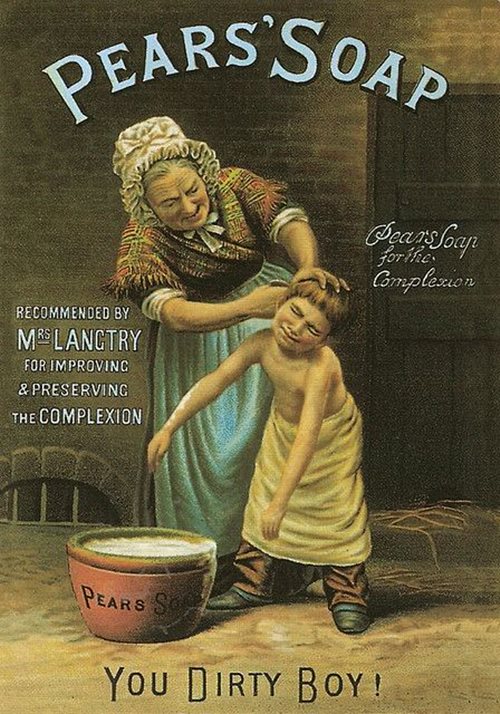
“The right use of text is also an essential part of creating the right poster,” continues “Die Presse”: “You have to be able to glimpse the advertisement content as you pass by. This is heeded by the English and Americans almost without exception in their large posters, and also by the Swiss, while elsewhere the rule is broken. Tangled, curly typefaces – used on placards so frequently in Austria – are only suitable for newspaper advertising, or for small posters hung inside public places, at train stations, in omnibus and tramway waiting rooms and carriages, in hotels and restaurants, etc., where the observer has the peace and quiet to read them. These elementary, self-explanatory rules are broken by almost all continental poster designers, apart from in Switzerland and Belgium”[34].
There was also hope for fresh impetus in Austrian poster design regarding the size of the affiches. As the “Österreichisch-ungarische Buchdrucker-Zeitung” reported: “The principal effect of a poster lies in its format. Gigantic sizes allow colours on a poster to achieve a greater effect due to their larger areas. Our business advertisers must therefore be educated to accept the size of this presentation, and it is possible that a visit to the poster exhibition will bring about such change.”[35] However, as the article in “Die Presse” continues, larger poster formats also mean higher costs, meaning that such a decision requires “a certain amount of business risk-taking to tread paths not yet explored by rivals, plus a good portion of shrewd ingenuity. Both of these are in abundance among the Americans and English, as can be seen all over the exhibition rooms. Among those on the continent, it is the Swiss who are closest to them in terms of activity and proficiency; in these countries the tourism industry has promoted a remarkable development in advertising, publicity and posters, and our Austrian mountain folk could learn a great deal in this exhibition especially in this regard.”[36]
The “Neues Wiener Tagblatt” reported that the production of posters in the USA costs “damned little”: “Depending on the format and richness of colour, the price ranges from 5 dollars to 106 dollars per 100 pieces. This last price, which seems to be the highest possible, is charged for a huge picture in all colours, large enough to serve as a ceiling for a medium-sized circus.”[37] And “Die Presse” refers to the economic viability of such financial investment in advertising: “A man who understands a thing or two about this – Barnum – is known to have published simple rules here; they show that investing 200,000 dollars in proper advertising brings in double and quadruple this amount, whereas small sums have a dubious effect.”[38]
This certainly seems to have been true for the organisers of the “Internationale Placat-Ausstellung”. Six days into the exhibition, they had already welcomed a total of 7,262 visitors, with interest in the presentation by no means limited to Vienna. For instance, the “Linzer Volksblatt” (which drew the attention of its readers in Upper Austria to the exhibition) reported: “A whole host of book printers and lithographers from Budapest arrived with their factors and workers to study the exhibition.”[39]
On 25 April 1888, at the end of the exhibition, the posters were auctioned off in the flower halls of the horticultural society. The auctioneer was Wilhelm v. Schwarz-Senborn, who “amused his audience yet also promoted the society’s charitable interests”[40] and accrued “five to six one-hundred banknotes, if not more”. A total of 2,703 guilders 40 kreutzer was generated in entrance fees – “an amount that can be described as not inconsiderable, in view of the low ticket prices of 20 and 10 kr.”[41], which means that the International Poster Exhibition had attracted over 13,500 visitors.
This shows that, contrary to previous descriptions in literature, Vienna played host at a relatively early stage not only to a representative, internationally stocked poster exhibition, but that the theoretical aspects of the medium were also examined in astonishing detail. It should not be forgotten that this was just one year before the Paris World Exposition in 1889, at which the poster gained wider international acceptance for the first time in an exhibition and with an award for the French poster pioneer Jules Chéret. It also means that there was indeed knowledge among the Habsburg monarchy of the technical and economic aspects associated with this form of advertising. Printing houses and enterprises were open-minded about such fresh impetus, although it would be another ten years before the Austrian art scene would adopt the poster as a means of advertising and expression in itself.
Translation: Rosemary Bridger-Lippe
[1] Neue Freie Presse, 15 April 1888, p. 5.
[2] Neues Wiener Tagblatt, 12 April 1888, p. 5.
[3] Neues Wiener Tagblatt, 17 April 1888, p. 4.
[4] Die Presse, 14 April 1888, p. 1.
[5] Horst Herbert Kossatz specifies the very first verifiable poster exhibitions as being two in Paris and one in Brussels; all three were held in 1884. The next exhibitions on his list of “Poster Exhibitions 1888 – 1914” are dated 1889; the exhibition in Vienna is not included here. Kossatz, Horst Herbert: Kossatz, Horst Herbert: Ornamentale Plakatkunst. Wiener Jugendstil 1897–1914, Wien 1971, p. 179. Christina Thon writes that the first poster exhibition “was held on the occasion of the Paris World Exposition in 1889”. Thon, Christina: “Zur Geschichte des französischen und belgischen Plakats”. In: Das frühe Plakat in Europa und den USA. Ein Bestandskatalog. Vol. 2, Berlin 1977, p. XLI.
[6] Catalogue de l’Exposition d’affiches artistiques, Reims 1896, p. 197ff.
[7] Neue Freie Presse, 10 April 1888, p. 5; Österreichisch-ungarische Buchdrucker-Zeitung, 5 April 1888, p. 141.
[8] Volkswirtschaftliche Wochenschrift, 19 April 1888, p. 301ff. Detailed articles on Dorn’s talk that were published in the “Wiener Zeitung” (25 February 1888, p. 7f.) and the “Kaufmännische Zeitschrift” (15 April 1888, p. 66f.) reveal that only minimal changes were made to the text for publication in the “Volkswirtschaftliche Wochenschrift”.
[9] Wiener Zeitung, 25 February 1888, p. 7f.
[10] Ibid., p. 8.
[11] Oesterreichische Buchhändler-Correspondenz, 3 April 1880, p. 125.
[12] Volkswirtschaftliche Wochenschrift, 19 April 1888, p. 302.
[13] Wiener Allgemeine Zeitung, 13 April 1888, p. 2.
[14] Österreichisch-ungarische Buchdrucker-Zeitung, 5 April 1888, p. 141.
[15] Neues Wiener Tagblatt, 12 April 1888, p. 5.
[16] Neues Wiener Abendblatt, 20 April 1888, p. 4.
[17] Neues Wiener Tagblatt, 15 April 1888, p. 4.
[18] Neue Freie Presse, 10 April 1888, p. 5.
[19] Neues Wiener Tagblatt, 12 April 1888, p. 5.
[20] Teplitz-Schönauer Anzeiger, 28 April 1888, p. 1.
[21] Wiener Allgemeine Zeitung, 14 April 1888, p. 2.
[22] Ibid.
[23] F. Čerwénka: Das Teplitzer Theater und Liszt in der Wiener Plakatenausstellung. In: Teplitz-Schönauer Anzeiger, 28 April 1888, p. 3.
[24] Die Presse, 20 April 1888, p. 11.
[25] Ibid.
[26] Österreichisch-ungarische Buchdrucker-Zeitung, 19 April 1888, p. 159.
[27] Ibid., p. 158.
[28] Ibid.
[29] Ibid.
[30] Wiener Allgemeine Zeitung, 13 April 1888, p. 1.
[31] Wiener Sonn- und Montagszeitung, 16 April 1888, p. 3.
[32] Die Presse, 14 April 1888, p. 1ff.
[33] Ibid., p. 2.
[34] Ibid., p. 2f.
[35] Österreichisch-ungarische Buchdrucker-Zeitung, 19 April 1888, p. 159.
[36] Die Presse, 14 April 1888, p. 2.
[37] Neues Wiener Tagblatt, 13 April 1888, p. 3.
[38] Die Presse, 14 April 1888, p. 1.
[39] Linzer Volksblatt, 18 April 1888, p. 3.
[40] Neues Wiener Tagblatt, 26 April 1888, p. 4.
[41] Ibid.
